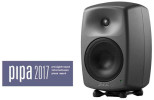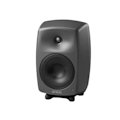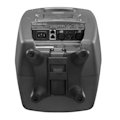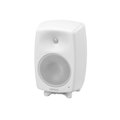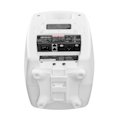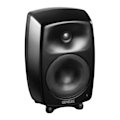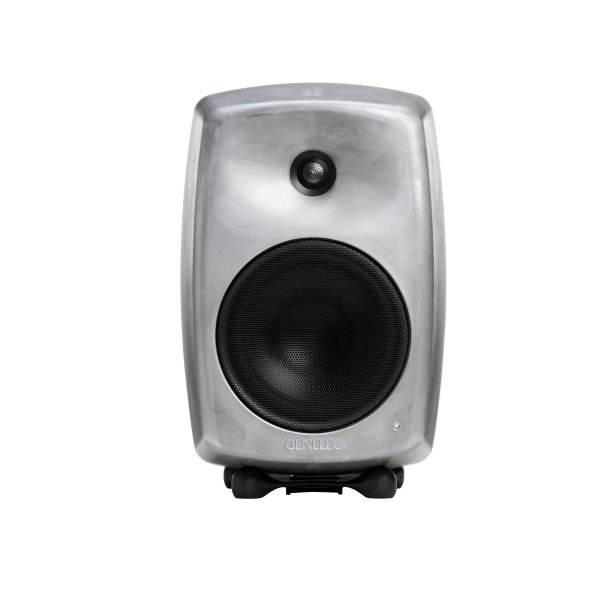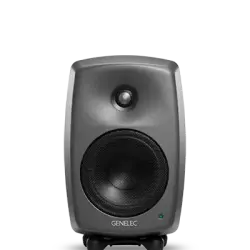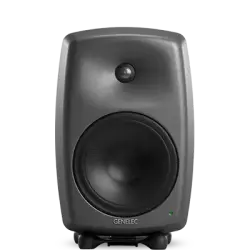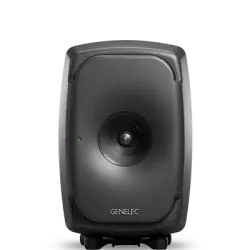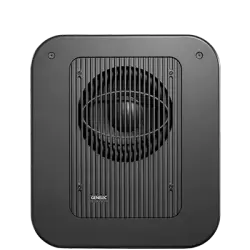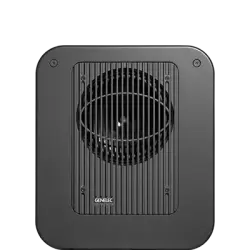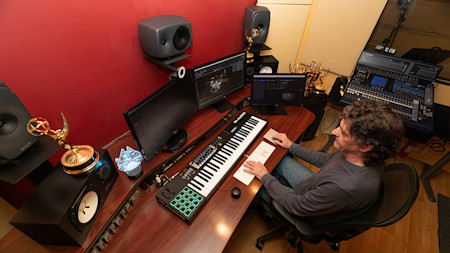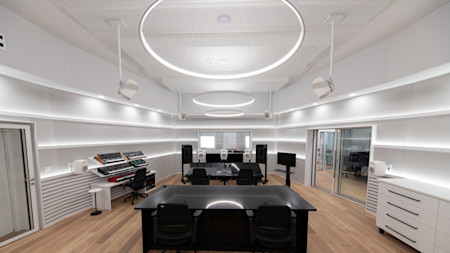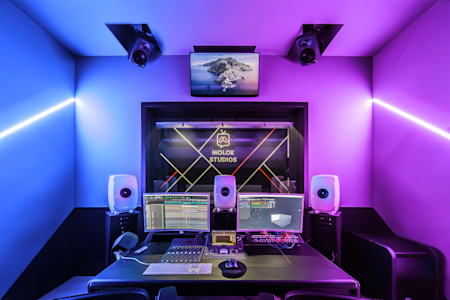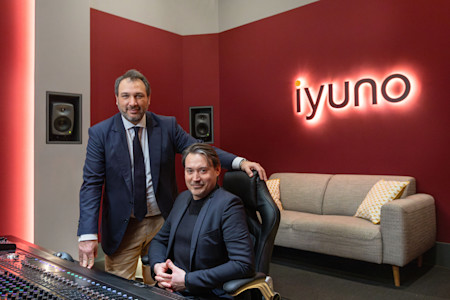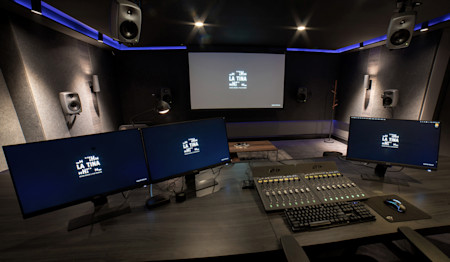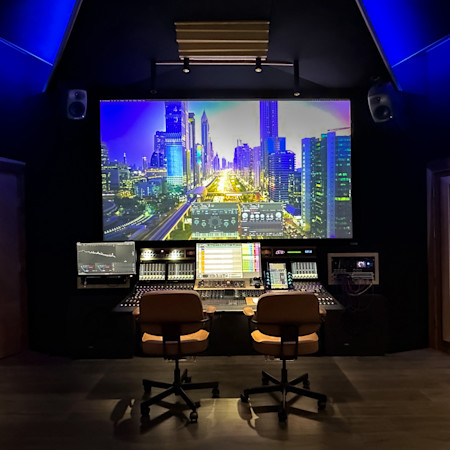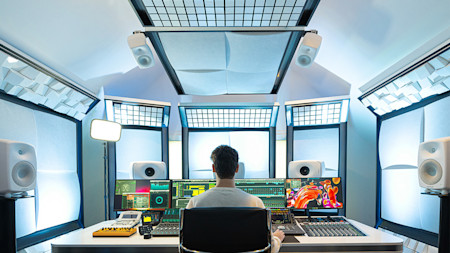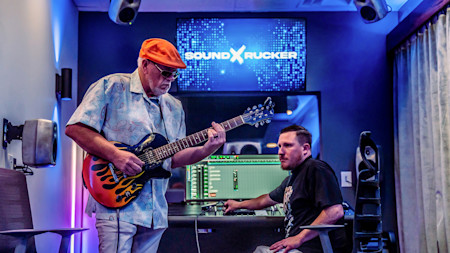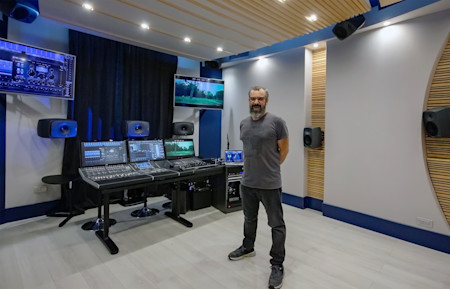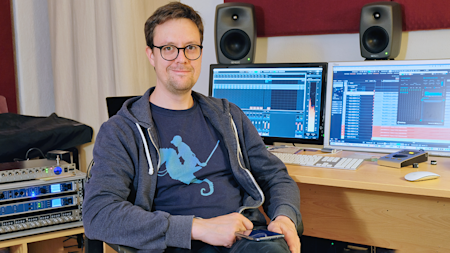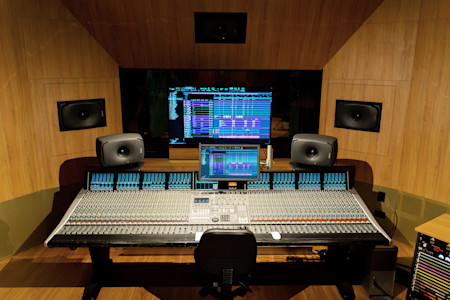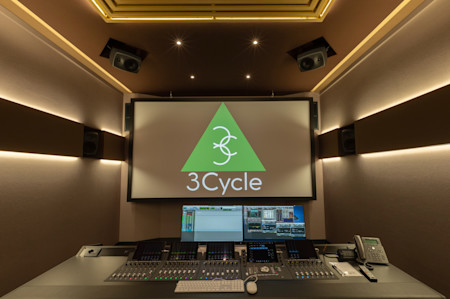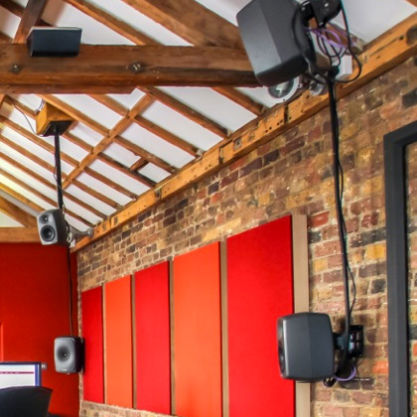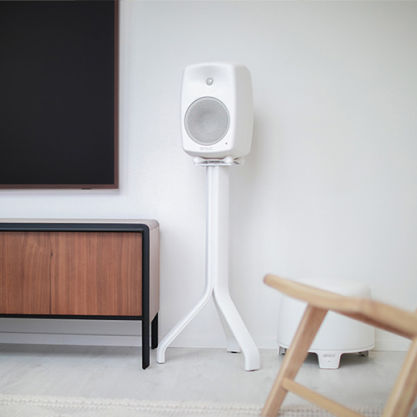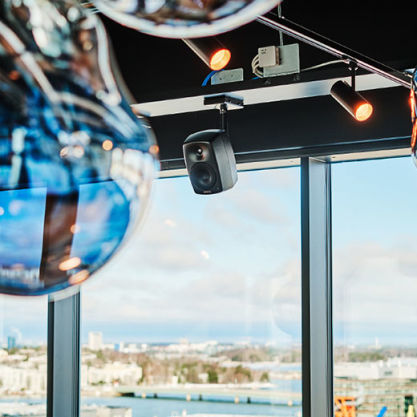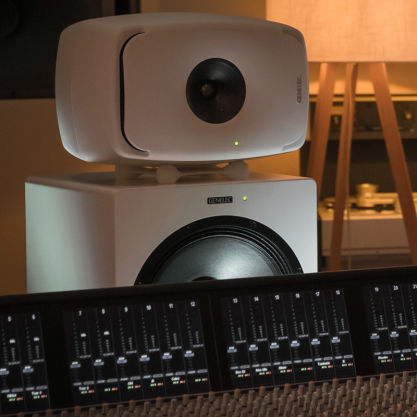Genelecin 8340A SAM™ älytarkkailukaiuttimen suorityskyky ja tarkkuus nostavat monitoroinnin luotettavuuden uudelle tasolle.
8340A
SAM™ Studiomonitori

Active Crossovers

Directivity Control Waveguide (DCW™)

SPL
110 dB

Taajuusvaste
38 Hz - 22 kHz (-6 dB)

Mitat
H 365 x W 237 x D 223 mm, Iso-Podin kanssa™ (muunna tuumiksi)

Soveltuu digitaalisiin ja analogisiin järjestelmäympäristöihin
8340A on erittäin kehittynyt tarkkailukaiutin, joka soveltuu sekä digitaalisiin että analogisiin järjestelmäympäristöihin. Se soveltuu erinomaisesti äänitysstudioihin, jälkituotantoon, digitaalisiin editointijärjestelmiin, sekä radio-, TV- ja ulkotuotantoon. 8340A:n ansiosta voit keskittää kaiken luovuutesi työskentelyyn eikä sinun tarvitse huolehtia äänentoiston luotettavuudesta, paikasta riippumatta.

Korkea maksimiäänenpaine, laaja taajuuskaista ja värittymätön ääni
8340A:n erittäin korkea maksimiäänenpaine, laaja taajuuskaista ja värittymätön ääni ovat seurausta useista Genelecin kehittämistä teknologioista. Kaiuttimen Minimum Diffraction Enclosure (MDE™) -koteloon on integroitu Directivity Control Waveguide (DCW™) -ohjain sekä virtausoptimoitu refleksiputki. Elektroniikka sisältää Genelecin suunnitelemat D-luokan tehovahvistimet sekä universaalin virtalähteen. 8340A on täysin yhteensopiva vanhempien Smart Active Monitor (SAM™) -järjestelmien kanssa.
Genelec
8340A SAM™ Studiomonitori tummanharmaa
8340A SAM™ Studiomonitori valkoinen
8340A SAM™ Studiomonitori musta
8340A SAM™ Studiomonitori RAW
8340A
Palkinnot
Genelec 8340A SAM™ Studio Monitor was awarded with the Future Music Gear of the Year 2016 in "The Best Monitor" -category.
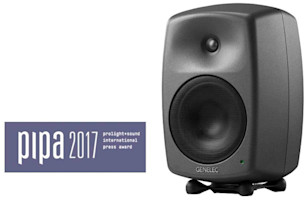
Genelec 8340A SAM Studio Monitor was awarded with the PIPA Pro Light & Sound International Press Award 2017 in the "Best Studio Monitor" category.

Anders Nyman from Genelec with the PIPA 2017 award for Best Studio Monitor
Tekniset tiedot

SPL
110 dB

Vahvistimen teho
150 W Basso (Class D) + 150 W Diskantti (Class D)

Taajuusvaste
38 Hz - 22 kHz ("-6 dB")

Taajuusvasteen tarkkuus
± 1.5 dB (45 Hz - 20 kHz)

Kaiutinelementtien mitat
⌀ 165 mm Basso + ⌀ 19 mm Diskantti (muunna tuumiksi)

Mitat
H 365 x W 237 x D 223 mm, Iso-Podin kanssa™ (muunna tuumiksi)

Paino
8.4 kg / 18.5 lb

Liitännät
1 x XLR Analoginen Sisääntulo
1 x XLR AES/EBU Sisääntulo
1 x XLR AES/EBU Ulostulo
2 x RJ45 Ohjaus
8340A
SAM™ Studiomonitori
Tekniset tiedot
Genelecin 8340A SAM™ älytarkkailukaiuttimen suorityskyky ja tarkkuus nostavat monitoroinnin luotettavuuden uudelle tasolle.

Järjestelmän tiedot
Taajuusvaste
45 Hz - 20 kHz (± 1.5 dB)
Alarajataajuus -6 dB
38 Hz
Ylärajataajuus -6 dB
22 kHz
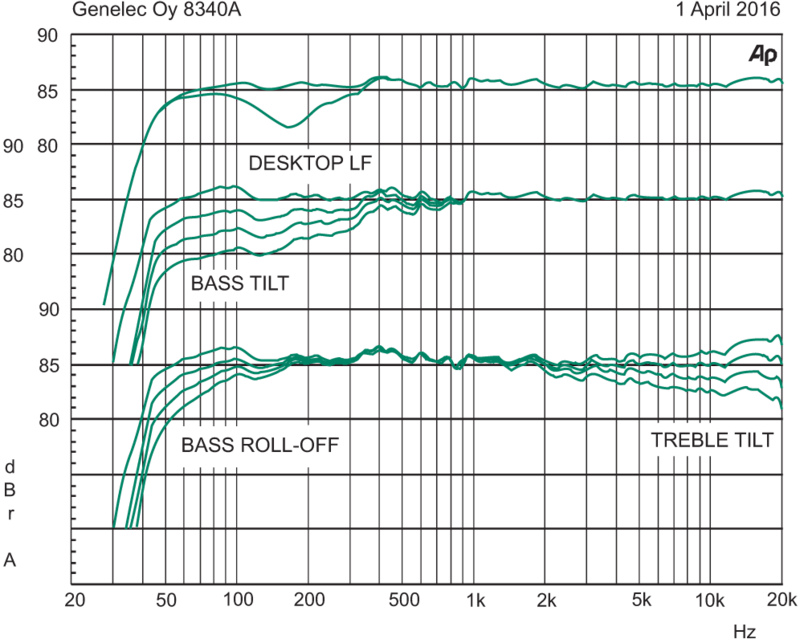
SPL
Maksimiäänenpaine Maximum peak acoustic output per pair in a listening room with music material at 1 m.
≥118 dB
Hetkellinen maksimiäänenpaine Maximum short term sine wave acoustic output on axis in half space, averaged from 100 Hz to 3 kHz at 1 m.
≥110 dB
Pitkäkestoinen maksimiäänenpaine Maximum long term RMS acoustic output in the same conditions with IEC weighted noise (limited by driver unit protection circuit) at 1 m.
≥100 dB
Akustinen pohjakohinataso
Akustinen pohjakohinataso Self generated noise level in free field on axis (A-weighted).
≤5 dB SPL
Paino
Paino8.4 kg (18.5 lb)
Mitat
Korkeus
350 mm
Korkeus pöytäjalustan kanssa
365 mm
Leveys
237 mm
Syvyys
223 mm
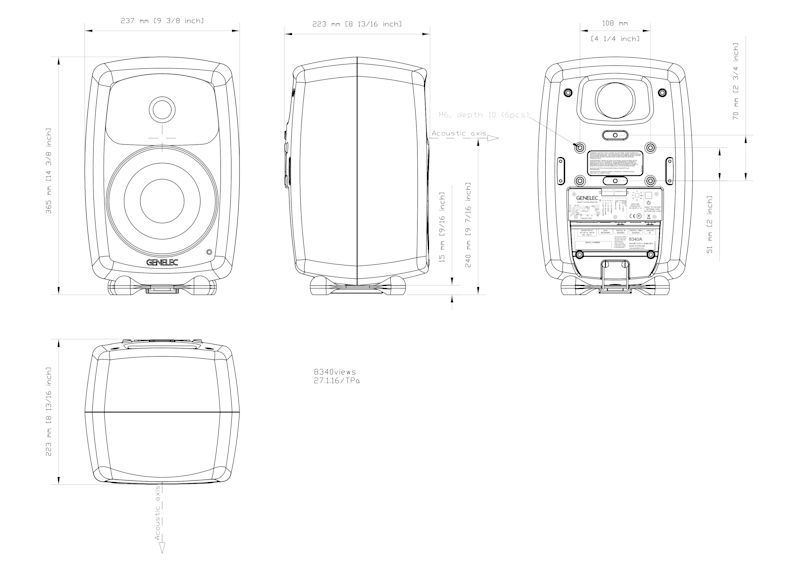
Kotelo
Kotelomateriaali
Die cast aluminium
Kotelotyyppi
Reflex port
Kaiutinelementit
Kaiutinelementtityyppi
Cone
Halkaisija
165 mm
Kaiutinelementtityyppi
Metal dome
Halkaisija
19 mm
Suuntaavuus
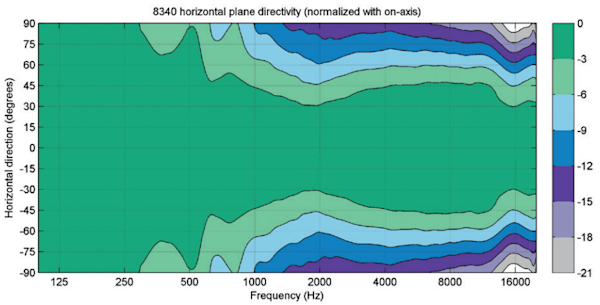
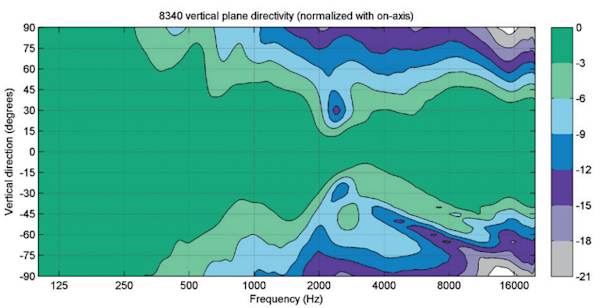
Harmoninen särö
> 100 Hz ≤0.5 %
Ryhmäviive
Viivästys äänen syntymiseen, mitattuna analogiasignaalitulosta korkeilla taajuuksilla.
GLM Extended Phase Linearity OFF-asennossa
3.0 ms (analogiatulo)
Genelec ilmoittaa kaiuttimen suorituskykytiedoissa ajan, joka kuluu äänen muodostumiseen siitä, kun sähköinen signaali on saapunut kaiuttimen tuloliittimeen. Tämä aika ilmoitetaan latenssina ja ryhmäviivekäyrän antamana viiveenä ja kaiuttimen aiheuttama kokonaisviive on näiden kahden summa. Jotta saa käsityksen tämän kokonaisviiveen merkittävyydestä, on hyvä tietää, että kaiuttimen siirtäminen 1 m kauemman tuottaa noin 3 ms lisäviiveen.
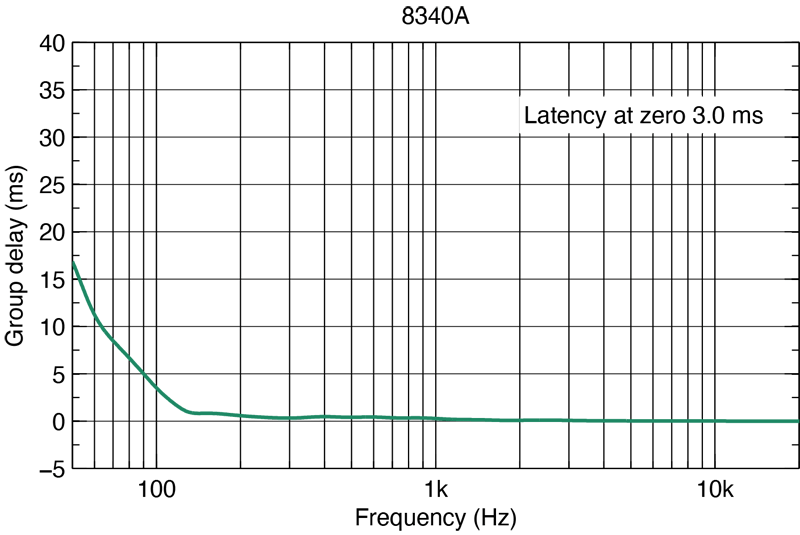
Vahvistimet
Vahvistimet
150 W Class D
150 W Class D
Käyttöjännite
100-240 VAC 50/60Hz
Tehonkulutus
ISS-valmiustilassa
≤1 W
Ilman kuormaa
≤12 W
Täysi kuormitus
180 W
Jakosuodin
Liitännät
Sisääntulo Analog signal input connector XLR female, balanced 10 kOhm.
Sisääntulo XLR-uros (vastaa standardia IEC 60958-4)
Ulostulo XLR-uros (vastaa standardia IEC 60958-4)
2 x Ohjaus RJ45-liittimet
Jakotaajuus
Tuotevaihtoehdot
Tuotekoodit
Lisävarusteet
Tuotekoodit
Tarkempia lisätietoja lisäksi tuoteoppaissa.
Avainteknologiat

Active Crossovers

Directivity Control Waveguide (DCW™)

Intelligent Signal Sensing (ISS™)

Iso-Pod™ Stand

Minimum Diffraction Enclosure (MDE™)

Optimized Amplifiers

Protection Circuitry

Reflex Port Design

Smart Active Monitor (SAM™)

Versatile Mountings
Aktiivisessa jakosuotimessa käsitellään linjatasoista signaalia.

Aktiiviset jakosuotimet jakavat audiosignaalin taajuuskaistoihin, jotka ohjataan erillisiin tehovahvistimiin. Vahvistimet on kytketty kyseiselle taajuuskaistalle optimoituihin kaiutinelementteihin.
Aktiivikaiuttimissa käytetään sekä digitaalisia että analogisia jakosuotimia. Genelecin digitaalisissa aktiivijakosuotimissa on myös muita signaalinkäsittelytoiminnallisuuksia, kuten elementtien suojaus, lentoaikakompensointi ja taajuuskorjaus.
Genelecin analogisissa aktiivijakosuotimissa perustuu elektronisiin komponentteihin, jotka käsittelevät matalatasoista signaalia ennen tehovahvistusta. Aktiiviset jakosuotimet eroavat toimintaperiaatteeltaan passiivisista jakosuotimista, joissa käsitellään voimakkaita signaaleja, suurta virtaa ja toisinaan myös suurta jännitettä.
Tyypillisessä kaksitiekaiuttimessa tulosignaali jakosuodatetaan kahdelle erilliselle tehovahvistimelle, joista toinen ohjaa bassoelementtiä ja toinen diskanttielementtiä.
Aktiivisella jakosuodinteknologialla on useita etuja:
- Elementin sähködynaamiset muutokset eivät vaikuta taajuusvasteeseen.
- Signaalia voidaan säätää joustavasti käytettävän elementin ominaisuuksien mukaisesti.
- Jokaisen elementin tulosignaali prosessoidaan ja vahvistetaan yksilöllisesti. Yksittäisten elementtien signaalit eivät häiritse toisiaan, mikä vähentää keskeismodulaatiosäröä ja yliohjausongelmia.
- Elementtien välisiä herkkyyseroja voidaan kompensoida.
- Elementin ominaisuuksiin liittyviä taajuus- ja vaihevasteen poikkeamia voidaan kompensoida halutulla päästökaistalla.
- Aktiivinen jakosuodin mahdollistaa lisäksi taajuusvasteen säätämisen sekä kaiuttimen optimoinnin kaiutinjärjestelmään ja erilaisiin kuunteluympäristöihin ilman ulkoisia taajuuskorjaimia. Tuloksena on yksinkertainen, luotettava, tehokas, tarkka ja johdonmukaisesti käyttäytyvä aktiivikaiutinjärjestelmä.
Directivity Control Waveguide (DCW™) -suuntain tuottaa tasaisen taajuusvasteen laajalle kuuntelualueelle.

Vallankumouksellinen Directivity Control Waveguide™ (DCW™) -teknologia parantaa huomattavasti suoraan säteilevän monitiekaiuttimen suorituskykyä.
Tavoite on sovittaa taajuusvaste ja elementtien suuntaavuus kaiuttimessa. Lopputuloksena saavutetaan erinomainen taajuusvaste sekä kaiuttimen akustisella akselilla että sivusta mitattuna.
Parantunut kontrolloitu suuntaavuus vähentää huoneheijastumia kuuntelupaikalle. Tämä parantaa stereokuvaa ja asettaa vähemmän vaatimuksia huoneakustiikalle.
DCW-teknologia parantaa elementin herkkyyttä jopa +6 dB:ä, mikä mahdollistaa suuremman kokonaisäänenpaineen vähentäen samalla säröä ja parantaen luotettavuutta.
###DCW™-suuntaimen tärkeimmät edut:
- Tasainen taajuusvaste laajemmalle kuuntelualueelle
- Parantunut suoran äänen suhde heijastuneeseen ääneen vähentää tilan vaikutusta lopputulokseen
- Tarkempi stereokuva
- Parantunut elementtien hyötysuhde
- Järjestelmän suurempi maksimiäänenpaine
- Pienentynyt elementtien särö
- Vähemmän kaiutinkotelon reunan aiheuttamaa äänen heijastumista
- Parantunut elementtien luotettavuus, koska saman äänenpaineen tuottamiseen tarvitaan vähemmän tehoa ja pienempi kalvon liikepoikkeama
Intelligent Signal Sensing (ISS™) -valmiustilatoiminto vähentää virrankulutusta.

Genelec kehitti vuonna 2013 Intelligent Signal-Sensing -piirin, joka täyttää sekä ErP-direktiivin vaatimukset että Genelecin omat direktiiviä tiukemmat vastuullisuusvaatimukset.
ISS™-piiri seuraa kaiuttimien signaalinsyöttöä ja havaitsee, milloin signaali on käytössä. Jos ISS-piiri ei havaitse audiosignaalia hetkeen, se asettaa kaiuttimen valmiustilaan, jossa kaiuttimen virrankulutus on alle 0,5 wattia. Kun syöttösignaali havaitaan, kaiutin kytkeytyy päälle itsestään. Kaiutinjärjestelmä alkaa siis säästää sähköä heti, kun työskentely katkeaa.
Jokaisen kaiuttimen taustalevyssä on huonevasteen säätimien vieressä ISS Disable -kytkin. Kun päävirtakytkin on asennossa ON, ISS™-toiminto on oletusarvoisesti päällä.
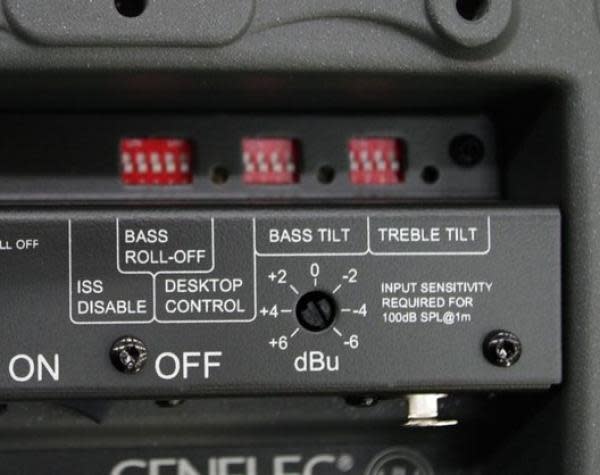
Jos ISS-toimintoa ei haluta käyttää, se voidaan poistaa käytöstä kääntämällä ISS Disable -kytkin asentoon ON. Tällöin kaiuttimen virransyöttöä ohjataan päävirtakytkimestä.
Päävirtakytkin katkaisee kaiuttimen virransyötön kokonaan.
Mekaanisia värinöitä vaimentava Iso-Pod™ -alusta parantaa äänikuvan tarkkuutta.

Vaikka vapaasti seisovien kaiuttimien alle suositellaan yleisesti tukevia jalustoja, on varsin yleistä että kaiuttimet sijoitetaan suoraan pöydälle tai äänipöydän mittarisillalle. Tällaisesta sijoituksesta aiheutuu kuitenkin haitallisia lieveilmiöitä: Kaiuttimen suuntaus kohti kuulijaa on vaikeaa ja kaiuttimen sekä alustan välille syntyy haitallisia mekaanisia värinöitä. Kaiuttimen ollessa pöydällä työtasosta aiheutuu heijastumia, jotka aiheuttavat kampasuodinilmiöstä johtuvaa taajuusvasteen vääristymistä.
Genelec on kehittänyt näiden ongelmien ratkaisemiseksi tehokkaan ja käytännöllisen Isolation Positioner/Decoupler (Iso-Pod™) -alustan, joka kiinnitetään jousella kaiuttimen alumiinikoteloon. Alusta on valmistettu joustavasta kumimaisesta materiaalista. Tukevasti sekä pysty- että vaaka-asentoon Iso-Pod-alustan päälle asettuvaa kaiutinta voidaan kallistaa ±15 asteen kulmaan. Kaiuttimen akustinen akseli voidaan kohdistaa tarkasti kohti kuuntelijaa säätämällä kaiuttimen kulmaa Iso-Pod-alustan päällä.
Mekaaniset eristys- ja vaimennusominaisuudet vähentävät tukipinnoista syntyvän haitallisen värähtelyn aiheuttamaa keskiäänen värittymistä.
Innovatiivinen Iso-Pod™-alusta on oleellinen osa Genelecin kaiutinmuotoilua ja se tarjoaa huomattavia käytettävyyteen sekä äänenlaatuun vaikuttavia etuja.
Minimum Diffraction Enclosure (MDE™) -kotelo tuottaa värittymättömän äänen.
Etulevyn akustisista epäjatkuvuuskohdista syntyvä diffraktio on tyypillinen vapaasti sijoiteltavan kaiuttimen ongelma. Kotelon terävät kulmat aiheuttavat heijastuksista johtuvia toisioäänilähteitä, jotka värittävät ääntä ja heikentävät äänikuvan tarkkuutta.
Parantaakseen vapaasti sijoiteltavan kaiuttimen taajuusvasteen sekä tehovasteen tasaisuutta, Genelec on kehittänyt innovatiivisen Minimum Diffraction Enclosure (MDE™) -kaiutinkotelon, jossa on kaarevat sivut sekä pyöristetyt kulmat. Poikkeuksellisen tasaisen taajuusvasteen lisäksi kotelorakenteella saavutetaan erinomaiset äänikuvaominaisuudet.
Kompaktin ja tyylikkään ulkoasun saavuttamiseksi kotelon materiaaliksi on valittu painevalettu alumiini, joka mahdollistaa kotelon kokoon suhteutettuna suuren sisätilavuuden bassoelementin herkkyyden maksimoimiseksi. Alumiini on kevyttä, jäykkää ja hyvin vaimentavaa, joten se on erinomainen materiaali ohutseinäisen ja akustisesti "kuolleen" kotelon valmistamiseen. Alumiinikotelo suojaa tehokkaasti elektromagneettiselta säteilyltä ja se toimii myös vahvistimien jäähdytyselementtinä. Kotelo valetaan kahtena kappaleena, jolloin se pystytään avaamaan helposti esimerkiksi huoltoa varten.
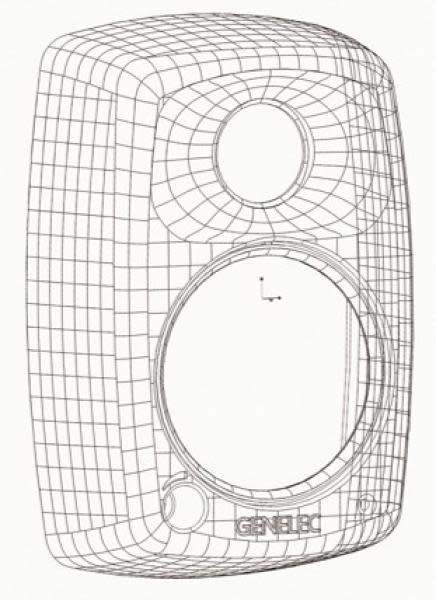
Directivity Control Waveguide (DCW™) -suuntain integroidaan MDE™-koteloon hallitun suuntaavuuden saavuttamiseksi. Vakiosuuntaavuuden alarajataajuus määräytyy suuntaimen koon perusteella, jolloin suuremmalla suuntainpinta-alalla saavutetaan hallitumpi suuntaavuuskäyttäytyminen. Hallittu sivukenttäsäteily mahdollistaa suuren käyttökelpoisen kuuntelualueen, mikä on erittäin tärkeää monikanavaisessa äänentarkkailussa. Hallittu suuntaavuus vähentää myös rajapintaheijasteiden merkitystä, jolloin monitorointijärjestelmä toimii johdonmukaisesti erilaisissa akustisissa ympäristöissä.

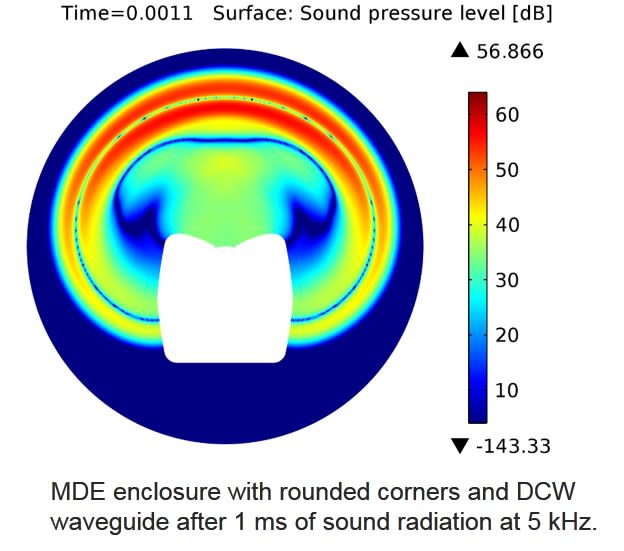
Elementtikohtaisesti optimoidut tehovahvistimet.
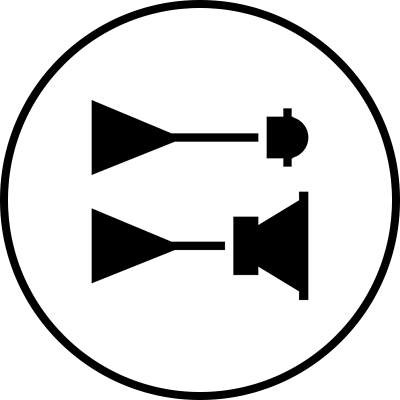
Elektroniset jakosuotimet jakavat audiosignaalin taajuuskaistan osiin, jotka voidaan ohjata erillisiin vahvistimiin. Vahvistimet on liitetty kyseiselle taajuuskaistalle optimoituihin muuntimiin.
Tyypillisessä kaksitiekaiuttimessa aktiivinen jakosuodin tarvitsee kaksi vahvistinta: yhden bassoelementille ja toisen diskanttielementille. Vahvistimet liitetään suoraan aktiivikaiuttimien elementteihin, jolloin vahvistimien kuormitus on tunnettu ja yksinkertaisempi. Jokaisella elementtikohtaisella vahvistimella on vain rajallinen taajuusalue, jota se vahvistaa (vahvistin sijoitetaan aktiivisen jakosuotimen taakse), mikä yksinkertaistaa rakennetta.
Aktiivisella rakenteella on useita etuja:
- Vahvistimet liitetään suoraan kaiutinelementteihin, mikä tehostaa vahvistimien elementin äänikäämin vaimennuksen hallintaa ja vähentää dynaamisten muutosten esiintymistä elementin sähköominaisuuksissa. Se saattaa parantaa järjestelmän siirtymävastetta.
- Vahvistimen lähtövaatimukset ovat pienemmät. Kun energiaa ei mene hukkaan passiivisen jakosuotimen komponenteissa, vahvistimen tehovaatimukset ovat huomattavasti pienemmät (jopa puolta pienemmät joissakin tapauksissa) ilman, että kaiuttimen akustinen teho heikkenee. Tämä saattaa pienentää kustannuksia ja parantaa äänenlaatua ja järjestelmän luotettavuutta.
- Kun vahvistimen ja elementin välissä ei tapahdu hävikkiä, saavutetaan äärimmäinen akustinen tehokkuus.
- Aktiivinen teknologia pystyy tuottamaan ylivoimaisen äänentoiston suhteessa kokoon ja matalaan alarajataajuuteen.
- Kaikki kaiuttimet toimitetaan tehtaalla sovitettuina järjestelminä (vahvistimet, jakosuotimet ja kotelo-elementtijärjestelmät).
Yliohjauksen suojapiiri takaa turvallisen käytön ja elementtien pitkäikäisyyden.

Kriittisissä audiotuotantoympäristöissä on ratkaisevaa, että monitorointijärjestelmä on luotettava ja aina käytettävissä. Yksi tärkeimmistä syistä Genelecin menestykseen lähetystarkkaamokäytössä on tuotteidemme luotettavuus. Luotettavuuden takeena on sisäinen suojapiiri, joka on ollut kaikissa tuotteissa vuodesta 1978 lähtien.
Suojapiiri ehkäisee elementtien vikatiloja havaitsemalla signaalitasoja. Mikäli signaalissa esiintyy yhtäkkisiä piikkejä tai jatkuvia liian korkeita tasoja, suojapiiri laskee signaalin tasoa automaattisesti. Suojapiirin toiminta ei luonnollisestikaan vaikuta äänenlaatuun millään tavalla työskenneltäessä kaiuttimen määritellyissä käyttöolosuhteissa. Se vain ehkäisee signaaleja rikkomasta kaiutinta.
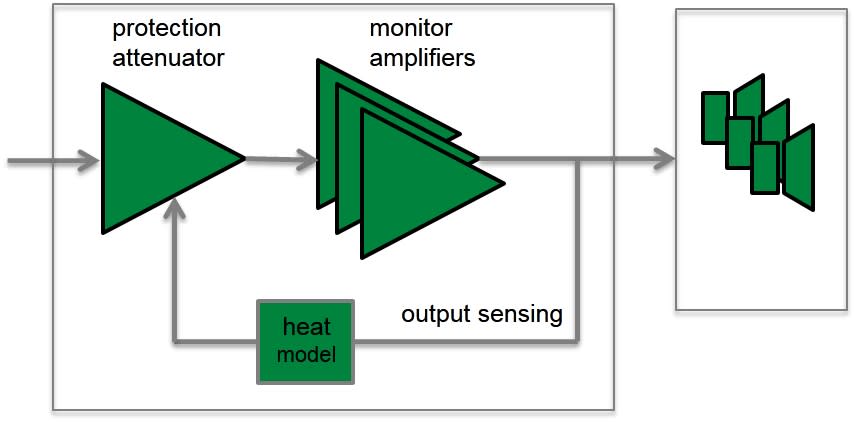
Suojapiirin ominaisuudet ja edut:
- Laskee signaalin tasoa tarvittaessa (esimerkiksi kun elementin äänikäämin lämpötila saavuttaa turvarajan), mikä parantaa kaiuttimen luotettavuutta merkittävästi.
- Jokaisen kaiuttimen ja alabassokaiuttimen sopiva suojapiirirakenne sallii järjestelmän äänitason maksimoimisen.
Edistynyt refleksiputken muotoilu parantaa bassotoiston ulottuvuutta.

Genelec käytti bassorefleksirakennetta jo ensimmäisessä tarkkailukaiuttimessaan S30:ssa vuonna 1978. Genelec on siitä lähtien tutkinut ja kehittänyt refleksiputken suorituskykyä sekä tehokkuutta. Kehitystyön tavoite on ollut parantaa bassotoiston ulottuvuutta ja äänenpainekapasiteettia erinomaisen matalien taajuuksien artikulaation ja tarkkuuden tuottamiseksi.
Sekä bassoelementti että refleksiaukko vaikuttavat refleksikotelon kokonaissäteilyyn. Suurin osa säteilystä on lähtöisin elementistä, mutta refleksikotelon resonanssitaajuudella elementin liikepoikkeaman amplitudi on pieni, jolloin suurin osa säteilystä tulee aukosta.
Virtausnopeuden minimoimiseksi putken poikkipinta-alan täytyy olla suuri. Kaiutinkotelon koko rajoittaa usein refleksiputken pituutta.
Pitkä kaareva refleksiputki maksimoi ilmavirtauksen, jotta kaiutin pystyy tuottamaan syvän bassotoiston ilman kompressiota. Putki päättyy leveään pyöreäreunaiseen aukkoon, joka sijaitsee kotelon takana minimoiden putken virtausääniä ja tuottaen erinomaisen bassoartikulaation.
Putken kaareva muoto on tarkoin suunniteltu ja se vähentää virtausääniä, kompressiota ja säröä. Putken sisäpään muotoilu minimoi suorille refleksiputkille tyypillisiä yskähdysääniä ja turbulenssia.
Huolellisesti suunniteltu refleksiputken rakenne vähentää bassoelementin liikepoikkeamaa ja parantaa matalien taajuuksien toiston lineaarisuutta sekä äänenpainekapasiteettia.
Smart Active Monitor (SAM™) älykkäät kaiutinjärjestelmät sisältävät automaattisen kalibroinnin akustiseen ympäristöön.

Kuluneen vuosikymmenen aikana sisällöntuotannon tarve on kasvanut ennätyslukemiin maailmanlaajuisesti. Tämä on aiheuttanut suuria muutoksia tuotantoyksiköiden toimintatapoihin kasvaneen työmäärän suorittamiseksi. Kasvava osa tuotannoista tehdään entistä pienemmissä työskentely-ympäristöissä. Tämä lisää merkittävästi huoneakustisia ongelmia jolloin äänentarkkailun luotettavuus heikkenee. Äänitarkkailijan tulisi pystyä luottamaan aukottomasti kaiutinjärjestelmään, jonka tulee tuottaa värittymätöntä ja särötöntä ääntä käytetystä äänenpaineesta riippumatta.
Huolellinen elektroakustinen suunnittelu toimii perustana kaikille 1200, 8200, 8300, 7200 ja 7300 –sarjojen älykkäille tarkkailukaiutintuotteille. SAM™ järjestelmän poikkeuksellisiin ominaisuuksiin kuuluu muun muassa kalibrointitoiminnallisuus Autocal™, joka mittaa ja sovittaa tarkkailukaiuttimet automaattisesti akustiseen ympäristöön kompensoiden tasoerot, viive-erot, taajuusvasteiden poikkeamat sekä subwoofereiden vaiheet.
SAM™ järjestelmiä ohjataan Genelecin Loudspeaker Manager (GLM™) ohjausverkkoa ja -sovellusta käyttäen, joka mahdollistaa äärimmäisen joustavan ja luotettavan monitorointijärjestelmän luomisen. GLM 3 on intuitiivinen tarkkailukaiuttimien hallintasovellus, joka mahdollistaa jopa 45 SAM™ -tuoteperheen tarkkailukaiuttimen ja subwooferin kytkemisen järjestelmään. Autocal™ automaattisen kalibrointitoiminnallisuuden lisäksi GLM 3 sovellus tarjoaa käyttäjälle mahdollisuuden säätää monipuolisesti tasoja, viiveitä sekä äänenvärisuodattimia. Parametrit ja asetukset voidaan tallentaa sekä tietokoneelle, että myös jokaiseen yksittäiseen GLM™ -ohjausverkkoon liitettyyn tarkkailukaiuttimeen ja subwooferiin. Tällöin ohjausverkkoa ja sovellusta ei välttämättä tarvita varsinaista tarkkailutyötä tehtäessä.
Kaikkia SAM™ järjestelmän tarjoamia toimintoja sekä äänen väriä voidaan säätää käyttäjän tarpeiden mukaisesti. Jopa työskentelytilan ja akustisen ympäristön vaihtuessa SAM™ teknologia auttaa sinua saavuttamaan parhaan mahdollisen ja johdonmukaisesti käyttäytyvän äänentarkkailujärjestelmän, joka tarjoaa neutraalin äänikuvan sekä todella alhaisen särötason.
Genelecin SAM™ -tuoteperhe tarjoaa kattavan, ratkaisukeskeisen ja älykkäästi verkottuvan järjestelmäkokonaisuuden, joka mahdollistaa sekä analogisen että digitaalisen signaalitien käyttämisen erilaisissa työskentely-ympäristöissä.
Monipuoliset kiinnitysvaihtoehdot soveltuvat useimpiin asennusratkaisuihin.

Genelecin kaiuttimissa on monipuoliset ripustusmahdollisuudet, jotka tekevät asennuksesta helppoa kaikissa kohteissa. Oikein sijoitetut kaiuttimet käyttäytyvät ihanteellisesti erilaisissa käyttöympäristöissä.
Laaja lisävarustevalikoimamme ja painevalettujen alumiinikoteloiden takalevyihin integroidut kiinteät M6-kiinnityspisteet tarjoavat ratkaisun useimpiin asennustilanteisiin. Pienissä kaiutinmalleissa kotelon pohjassa on 3/8-tuuman kierreinsertti, jota käyttäen kaiutin voidaan asentaa tukevaan mikrofonitelineeseen tai jalustaan. Suuremmissa ja painavammissa malleissa on M10-kiinnityspisteet. Lattiatelineisiin on saatavilla myös mallikohtaiset Iso-Pod jalusta-adapterit, joiden avulla saavutetaan kattavat säätömahdollisuudet sekä hyvä mekaaninen eristys kaiuttimen ja jalustan välille.
Näiden ominaisuuksien ansiosta tuotteitamme käytetään nykypäivänä ammattikäyttökohteiden lisäksi sekä julkistiloissa että kotikohteissa kaikkialla maailmassa.
Referenssit
Genelec UNIO Explained | How the ecosystem offers seamless in-room and personal headphone monitoring
One on One with Hugo Candelario | Interview
Using GLM | Walkthrough
Using GLM | The foundations
Using GLM | Controlling GLM with MIDI
Using GLM | GRADE Room Acoustic Report
Using GLM | Calibration Group IDs
Using GLM | Accounts and product registration
Using GLM | The technical details
Genelec UNIO Explained | How the ecosystem offers seamless in-room and personal headphone monitoring
A quick guide to our UNIO Ecosystem – which offers audio engineers seamless bridging of in-room and personal headphone monitoring. https://genelec.com/UNIO
The Genelec UNIO Ecosystem – which combines the power of our renowned GLM, SAM Monitoring and Aural ID adaptive technologies – gives audio engineers the flexibility to work anywhere, anytime, from stereo to immersive. And now, with the new UNIO Personal Reference Monitoring (PRM) solution, audio professionals benefit from the pinpoint accuracy of our pioneering active monitoring headphone solution, which combines the 9320A SAM Reference Controller with uniquely factory-calibrated 8550A Professional Reference Headphones.
To learn more, visit https://genelec.com/UNIO
Etsi jälleenmyyjäsi


